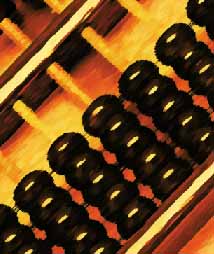|
Abacus
{ab'-uh-kuhs} An abacus is an instrument that helps a person make arithmetic calculations. In its best-known form, as the Chinese suan pan, it is composed of beads strung on parallel wires in a rectangular frame. In ancient times, however, the abacus was composed of a row of grooves in sand into which pebbles were placed. Later, the use of a slate or a board (in Greek, abax, from which the current name is derived) made it a portable device; and the pebbles were systematically arranged along parallel lines. The value assigned to each pebble (or bead, shell, or stick) is determined not by its shape but by its position: one pebble on a particular line or one bead on a particular wire has the value of 1; two together have the value of 2. A pebble on the next line, however, might have the value of 10, and a pebble on the third line would have the value of 100. Therefore, three properly placed pebbles--two with values of 1 and one with the value of 10--could signify 12, and the addition of a fourth pebble Thus the abacus works on the principle of place-value notation: the location of the bead determines its value. In this way, relatively few beads are required to depict large numbers. The beads are counted, or given numerical values, by shifting them in one direction. The values are erased (freeing the counters for reuse) by shifting the beads in the other direction. An abacus is used simply as a memory aid by a person making mental calculations. In contrast, ADDING MACHINES, electronic calculators, and computers are used to make physical calculations. Thomas M. Smith |
 |
E-commerce | Inbound Calling | Outbound Calling | Short Messaging Services Contact Us | Customer Log-in | Virtual Tour Overview | Services | History | Our People | Reporting | System News | Career Opportunities | Home |
|
